The Intel Core i3-7350K (60W) Review: Almost a Core i7-2600K
by Ian Cutress on February 3, 2017 8:00 AM ESTShadow of Mordor
The final title in our testing is another battle of system performance with the open world action-adventure title, Shadow of Mordor. Produced by Monolith using the LithTech Jupiter EX engine and numerous detail add-ons, SoM goes for detail and complexity to a large extent, despite having to be cut down from the original plans. The main story itself was written by the same writer as Red Dead Redemption, and it received Zero Punctuation’s Game of The Year in 2014.
For testing purposes, SoM gives a dynamic screen resolution setting, allowing us to render at high resolutions that are then scaled down to the monitor. As a result, we get several tests using the in-game benchmark. For low-end graphics we examine at 720p with low settings, whereas mid and high-end graphics get 1080p Ultra. The top graphics test is also redone at 3840x2160, also with Ultra settings, and we also test two cards at 4K where possible.
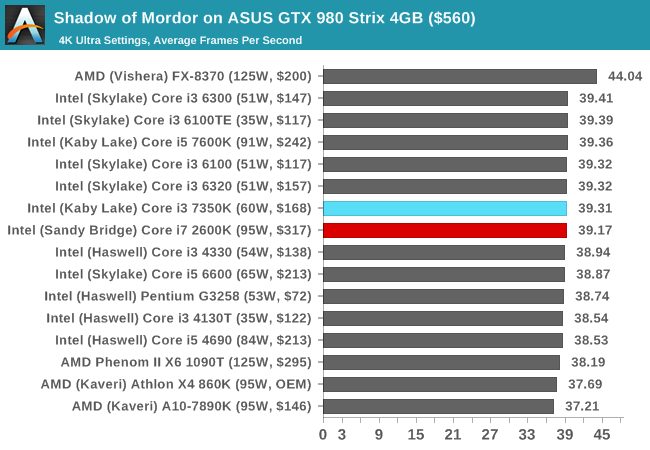
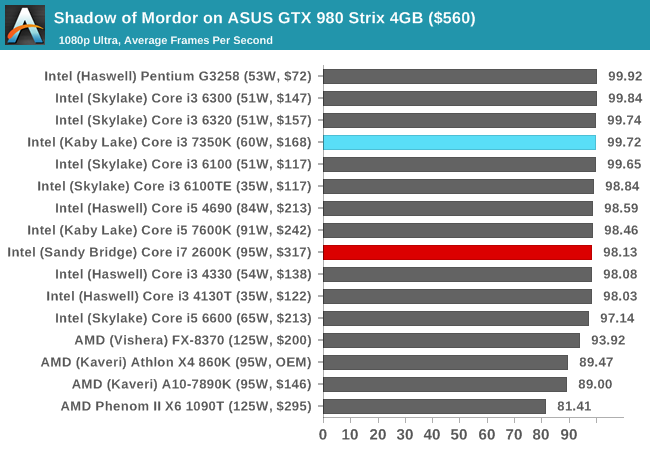
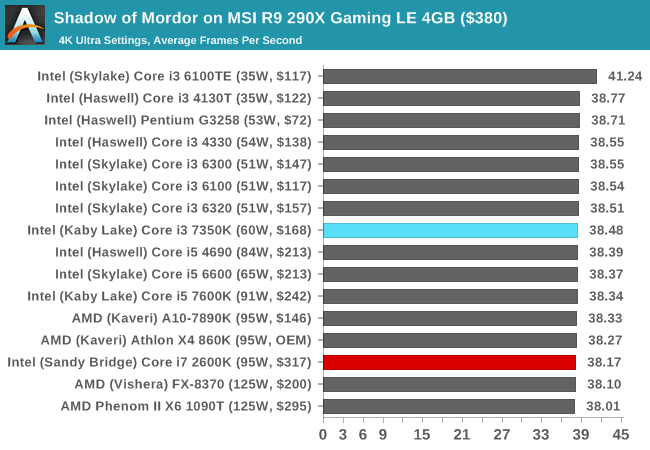

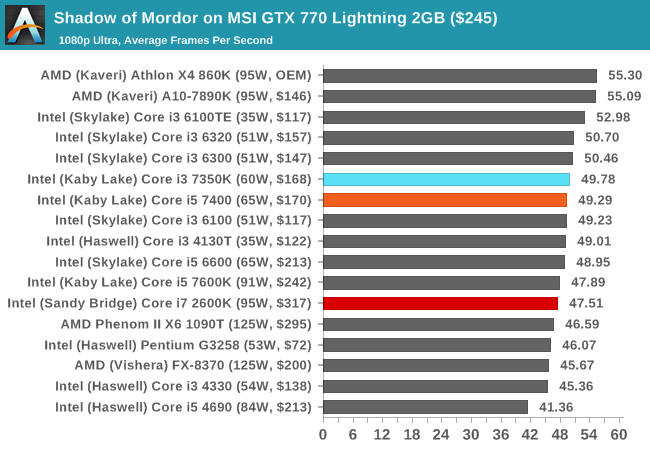
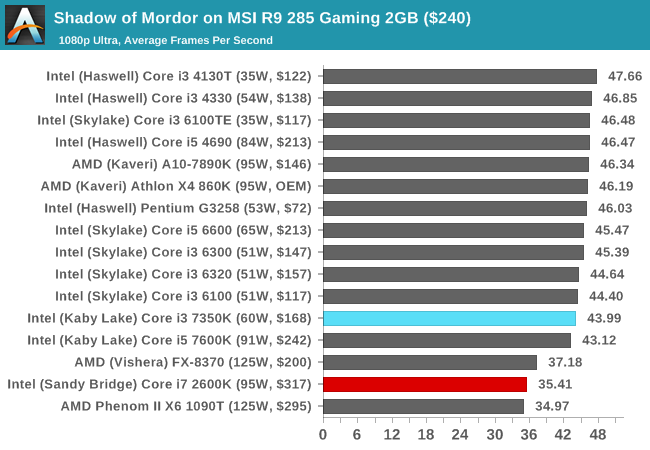

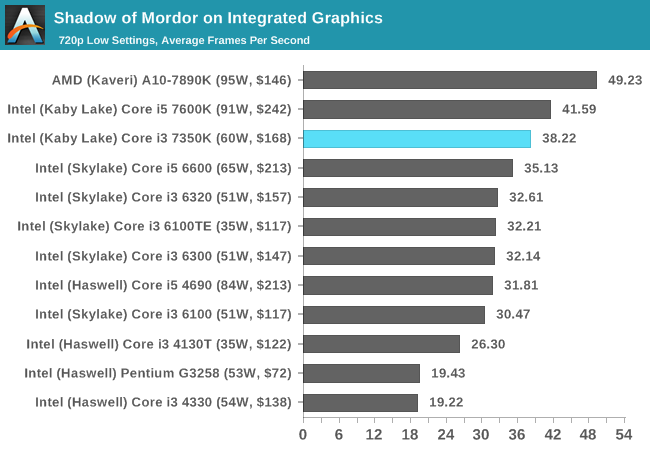
The only real difference here between the newer Core i3-7350K and the older Core i7-2600K is with our mid-range cards (GTX 770 and R9 285), whereby the older CPU seems to have a deficit 'in general' to the other CPUs we've tested. This might be CPU instruction related, although these results aren't seen on the other cards.











186 Comments
View All Comments
BillBear - Friday, February 3, 2017 - link
For consumers who intend to purchase a discrete GPU card, it's interesting to see it confirmed that Intel could include four additional CPU cores in instead of the unnecessary (for you) integrated GPU within pretty much the exact same die size.It wouldn't cost them more to manufacture than an i7. They just want to be able to charge more money by forcing you into a different price range of product if you need many cores.
For instance: Intel’s new 10-core Core i7 Extreme Edition costs a whopping $1,723
http://www.geek.com/tech/intels-new-10-core-core-i...
fanofanand - Friday, February 3, 2017 - link
I'm not sure I agree with your assessment. Intel has a vested interest in pushing people like you into the HEDT platform which is far more profitable. If you have a powerful dGPU then you are not "mainstream" by Intel's thinking. Based on the number of computers that have no dGPU maybe they are right.BillBear - Friday, February 3, 2017 - link
You're just defending price gouging now.fanofanand - Sunday, February 5, 2017 - link
I am not defending anything, I am neither an Intel shareowner nor have they seen a penny of mine in a decade. I am saying that what they are doing makes business sense even if it doesn't suit you as well as you'd like.BillBear - Sunday, February 5, 2017 - link
For someone who frequently responds to other people's posts with silly BS like "This post brought to you by CompanyName" why are you suddenly defending price gouging on Intel's part?Price gouging makes business sense for any company. Tacking on an additional thousand dollars per part? Not really defensible.
block2 - Friday, February 3, 2017 - link
The CPU I want is one that costs me the least electricity for the 95% of the time when I'm on Facebook and surfing, yet supports Photoshop well. I bought a gold rated seasonic PSU a couple years ago and my overall power usage is very low (40w?). Really, a low end i3 ought to suffice for me. I'm still using a 2.8ghz AMD phenom II with the CPU throttling enabled (800mhz).Scipio Africanus - Friday, February 3, 2017 - link
Have you considered one of the Intel T suffix cores? They don't get a lot of coverage but give you the newest architecture with a very low TDP. The current Kaby Lake T cores are 35w TDP.The newest review i could find was for Haswell T cores:
http://www.anandtech.com/show/8774/intel-haswell-l...
Scipio Africanus - Friday, February 3, 2017 - link
It takes Intel 6 years to post 25% increase in single threaded performance? Yeesh. Competiton (read: Ryzen) can't come fast enough. My Sandy Bridge Dell Precision is staying put for a bit more.StrangerGuy - Friday, February 3, 2017 - link
And AMD did what exactly during the same 6 years? Sheesh.silverblue - Saturday, February 4, 2017 - link
Well, they've transformed a power-hungry server architecture into something that the majority of users could use in a mobile device without complaining about power or performance. I'm also pretty sure that if they had commissioned Zen even before Bulldozer's release, we still wouldn't have seen anything until recently. I'm not going to defend them for Bulldozer, but it was either trash it and work on a replacement with no money coming in or at least try to fix its problems with power, L1 and decoder, and redesign the FPU. A 25%+ IPC boost from Bulldozer to Excavator, despite the loss of L3, would have been much better received had Bulldozer been better to begin with. That's what AMD have been doing.